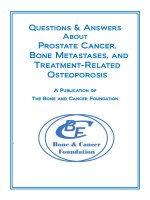Neurocritical care board review questions answers
Bạn đang xem bản rút gọn của tài liệu. Xem và tải ngay bản đầy đủ của tài liệu tại đây (4.29 MB, 479 trang )
Neurocritical Care
Board Review
Zakaria_87574_PTR_CH00_10-06-13_i-xx.indd iZakaria_87574_PTR_CH00_10-06-13_i-xx.indd i 6/19/2013 8:43:22 PM6/19/2013 8:43:22 PM
Zakaria_87574_PTR_CH00_10-06-13_i-xx.indd iiZakaria_87574_PTR_CH00_10-06-13_i-xx.indd ii 6/19/2013 8:43:22 PM6/19/2013 8:43:22 PM
Neurocritical Care
Board Review
Questions and
Answers
Editor
Asma Zakaria, MD
Assistant Professor
Departments of Neurology and Neurosurgery
Fellowship Director, Neurocritical Care
Division of Neurocritical Care
University of Texas, Health Science Center at Houston
New York
Zakaria_87574_PTR_CH00_10-06-13_i-xx.indd iiiZakaria_87574_PTR_CH00_10-06-13_i-xx.indd iii 6/19/2013 8:43:22 PM6/19/2013 8:43:22 PM
Visit our website at www.demosmedpub.com
ISBN: 978-1-936287-57-4
eISBN: 978-1-61705-033-6
Acquisitions Editor: Beth Barry
Compositor: Newgen Imaging Systems, Ltd.
© 2014 Demos Medical Publishing, LLC. All rights reserved. This book is protected by copyright. No part of it may
be reproduced, stored in a retrieval system, or transmitted in any form or by any means, electronic, mechanical, pho-
tocopying, recording, or otherwise, without the prior written permission of the publisher.
Medicine is an ever-changing science. Research and clinical experience are continually expanding our knowledge, in
particular our understanding of proper treatment and drug therapy. The authors, editors, and publisher have made
every effort to ensure that all information in this book is in accordance with the state of knowledge at the time of
production of the book. Nevertheless, the authors, editors, and publisher are not responsible for errors or omissions
or for any consequences from application of the information in this book and make no warranty, express or implied,
with respect to the contents of the publication. Every reader should examine carefully the package inserts accom-
panying each drug and should carefully check whether the dosage schedules mentioned therein or the contraindi-
cations stated by the manufacturer differ from the statements made in this book. Such examination is particularly
important with drugs that are either rarely used or have been newly released on the market.
Library of Congress Cataloging-in-Publication Data
Neurocritical care board review / [edited by] Asma Zakaria.
p. ; cm.
Includes bibliographical references and index.
ISBN 978-1-936287-57-4 — ISBN 978-1-61705-033-6 (ebook)
I. Zakaria, Asma, editor of compilation.
[DNLM: 1. Nervous System Diseases—therapy—Examination Questions. 2. Critical Care—Examination Questions.
WL 18.2]
616.02’8—dc23 2013001190
Printed in the United States of America by Bradford and Bigelow.
13 14 15 16 17 / 5 4 3 2 1
Special discounts on bulk quantities of Demos Medical Publishing books are available to corporations, professional
associations, pharmaceutical companies, health care organizations, and other qualifying groups.
For details, please contact:
Special Sales Department
Demos Medical Publishing
11 West 42nd Street, 15th Floor
New York, NY 10036
Phone: 800-532-8663 or 212-683-0072
Fax: 212-941-7842
Email:
Zakaria_87574_PTR_CH00_10-06-13_i-xx.indd ivZakaria_87574_PTR_CH00_10-06-13_i-xx.indd iv 6/19/2013 8:43:22 PM6/19/2013 8:43:22 PM
To My Parents– For their support and patience
Zakaria_87574_PTR_CH00_10-06-13_i-xx.indd vZakaria_87574_PTR_CH00_10-06-13_i-xx.indd v 6/19/2013 8:43:22 PM6/19/2013 8:43:22 PM
Zakaria_87574_PTR_CH00_10-06-13_i-xx.indd viZakaria_87574_PTR_CH00_10-06-13_i-xx.indd vi 6/19/2013 8:43:22 PM6/19/2013 8:43:22 PM
vii
Contents
Contributors xi
Preface xvii
PART I: NEUROLOGIC DISEASE STATES: PATHOLOGY, PATHOPHYSIOLOGY, AND THERAPY
Section I: Cerebrovascular Diseases
1. Infarction, Ischemia, and Hemorrhage 3
John J. Volpi
2. Subarachnoid Hemorrhage and Vascular Malformations 19
Bülent Yapicilar and Asma Zakaria
Section II: Neurotrauma
3. Neurotrauma 35
Scott R. Shepard
Section III: Disorders, Diseases, Seizures, and Epilepsy
4. Seizures and Epilepsy 51
Grant M. Warmouth
5. Neuromuscular Medicine 71
Suur Biliciler, Justin Kwan, and Cecile L. Phan
6. CNS Infections 79
Doris Kung
Zakaria_87574_PTR_CH00_10-06-13_i-xx.indd viiZakaria_87574_PTR_CH00_10-06-13_i-xx.indd vii 6/19/2013 8:43:22 PM6/19/2013 8:43:22 PM
CONTENTS
viii
7. Toxic–Metabolic Disorders 95
Elissa K. Fory
8. Infl ammatory and Demyelinating Diseases 107
Flavia Nelson
9. Neuroendocrine Disorders 121
Matthew Flaherty and Howard J. Fan
10. Neuro-Oncology 131
Yoshua Esquenazi and Nitin Tandon
11. Encephalopathies 141
Corey E. Goldsmith
12. Clinical Syndromes 159
Howard J. Fan and Asma Zakaria
13. Perioperative Neurosurgical Care 175
Yoshua Esquenazi and Nitin Tandon
14. Pharmacology and Practical Use of Medications in Neurocritical Care 183
Teresa A. Allison and Sophie Samuel
PART II: GENERAL CRITICAL CARE: PATHOLOGY, PATHOPHYSIOLOGY, AND THERAPY
15. Cardiovascular Physiology 205
David J. Powner
16. Cardiovascular Diseases 217
Jean Onwuchekwa Ekwenibe, Francisco Fuentes, Siddharth Mukerji,
Husnu Evren Kaynak, Nicoleta Daraban, Charles Hebenstreit, and
Ketan Koranne
17. Pulmonary Physiology and Fundamentals of Mechanical Ventilation 239
David J. Powner
18. Respiratory Diseases 267
Imoigele P. Aisiku
19. Renal Diseases 285
Ala Abudayyeh and Maen Abdelrahim
20. Electrolyte and Endocrine Disorders 299
David J. Powner
21. Infectious Diseases 319
Safdar A. Ansari
Zakaria_87574_PTR_CH00_10-06-13_i-xx.indd viiiZakaria_87574_PTR_CH00_10-06-13_i-xx.indd viii 6/19/2013 8:43:22 PM6/19/2013 8:43:22 PM
CONTENTS
ix
22. Acute Hematologic Disorders 333
Jitesh Kar and Hanh T. Truong
23. Acute Gastrointestinal and Genitourinary Disorders 349
Luis J. Garcia and Asad Latif
24. Diagnosis of Brain Death 361
David J. Powner
25. General Trauma and Burns 371
Sasha D. Adams and Amy R. Alger
26. Ethical and Legal Aspects of Critical Care Medicine 383
Nasiya Ahmed
27. Principles of Research in Critical Care 391
Suur Biliciler and Justin Kwan
28. Procedural Skills and Monitoring 397
George W. Williams
29. Clinical Cases 415
Asma Zakaria and Bülent Yapicilar
Index 433
Zakaria_87574_PTR_CH00_10-06-13_i-xx.indd ixZakaria_87574_PTR_CH00_10-06-13_i-xx.indd ix 6/19/2013 8:43:22 PM6/19/2013 8:43:22 PM
Zakaria_87574_PTR_CH00_10-06-13_i-xx.indd xZakaria_87574_PTR_CH00_10-06-13_i-xx.indd x 6/19/2013 8:43:22 PM6/19/2013 8:43:22 PM
xi
Contributors
Maen Abdelrahim, MD, PhD
Resident
Department of Internal Medicine
Baylor College of Medicine
Houston, Texas
Ala Abudayyeh, MD
Assistant Professor
Department of General Internal Medicine
Division of Nephrology
University of Texas, MD Anderson Cancer Center
Houston, Texas
Sasha D. Adams, MD
Assistant Professor
Department of Surgery
Division of Trauma and Critical Care
University of North Carolina, School of Medicine
Chapel Hill, North Carolina
Nasiya Ahmed, MD
Assistant Professor
Department of Internal Medicine
Division of Geriatric and Palliative Medicine
University of Texas, Health Science Center at Houston
Houston, Texas
Zakaria_87574_PTR_CH00_10-06-13_i-xx.indd xiZakaria_87574_PTR_CH00_10-06-13_i-xx.indd xi 6/19/2013 8:43:22 PM6/19/2013 8:43:22 PM
CONTRIBUTORS
xii
Imoigele P. Aisiku, MD
Associate Professor
Department of Neurosurgery
Division of Neurocritical Care
University of Texas, Health Science Center at Houston
Houston, Texas
Amy R. Alger, MD, FACS
Assistant Professor
Department of Surgery
Division of Trauma and Critical Care
University of North Carolina, School of Medicine
Chapel Hill, North Carolina
Teresa A. Allison, PharmD, BCPS
Neurosciences Clinical Pharmacy Specialist
Memorial Hermann–Texas Medical Center
Houston, Texas
Safdar A. Ansari, MD
Assistant Professor
Department of Neurosurgery
Division of Neurocritical Care
University of Utah
Salt Lake City, Utah
Suur Biliciler, MD
Assistant Professor
Department of Neurology
Neuromuscular Diseases Section
University of Texas, Health Science Center at Houston
Houston, Texas
Nicoleta Daraban, MD
Chief Cardiovascular Fellow
Department of Internal Medicine
University of Texas, Health Science Center at Houston
Houston, Texas
Jean Onwuchekwa Ekwenibe, MD
Cardiovascular Fellow
Department of Internal Medicine
University of Texas, Health Science Center at Houston
Houston, Texas
Zakaria_87574_PTR_CH00_10-06-13_i-xx.indd xiiZakaria_87574_PTR_CH00_10-06-13_i-xx.indd xii 6/19/2013 8:43:22 PM6/19/2013 8:43:22 PM
CONTRIBUTORS
xiii
Yoshua Esquenazi, MD
Chief Resident
Department of Neurosurgery
University of Texas, Health Science Center at Houston
Houston, Texas
Howard J. Fan, MD
Neurocritical Care Fellow
Department of Neurosurgery
Ronald Reagan UCLA Medical Center
Los Angeles, California
Matthew Flaherty, MD
Neurocritical Care Fellow
Department of Neurosurgery
University of Texas, Health Science Center at Houston
Houston, Texas
Elissa K. Fory, MD
Department of Neurosciences
Winthrop University Hospital
Mineola, New York
Francisco Fuentes, MD
Professor
Department of Internal Medicine
Division of Cardiology
University of Texas, Health Science Center at Houston
Houston, Texas
Luis J. Garcia, MD
Department of Surgery
Division of Acute Care Surgery
Johns Hopkins University School of Medicine
Baltimore, Maryland
Corey E. Goldsmith, MD
Assistant Professor
Department of Neurology
Baylor College of Medicine
Houston, Texas
Zakaria_87574_PTR_CH00_10-06-13_i-xx.indd xiiiZakaria_87574_PTR_CH00_10-06-13_i-xx.indd xiii 6/19/2013 8:43:23 PM6/19/2013 8:43:23 PM
CONTRIBUTORS
xiv
Charles Hebenstreit, MD
Chief Resident
Department of Internal Medicine
University of Texas, Health Science Center at Houston
Houston, Texas
Jitesh K. Kar, MD, MPH
Chief Resident
Department of Neurology
University of Texas, Health Science Center at Houston
Houston, Texas
Husnu Evren Kaynak, MD
Cardiovascular Fellow
Department of Internal Medicine
University of Texas, Health Science Center at Houston
Houston, Texas
Ketan Koranne, MD
Resident
Department of Internal Medicine
University of Texas, Health Science Center at Houston
Houston, Texas
Doris H. Kung, DO
Assistant Professor
Department of Neurology
Baylor College of Medicine
Houston, Texas
Justin Kwan, MD
Assistant Professor
Department of Neurology
University of Maryland School of Medicine
Baltimore, Maryland
Asad Latif, MD, MPH
Assistant Professor
Department of Anesthesiology and Critical Care Medicine
Division of Adult Critical Care Medicine
Johns Hopkins University School of Medicine
Baltimore, Maryland
Zakaria_87574_PTR_CH00_10-06-13_i-xx.indd xivZakaria_87574_PTR_CH00_10-06-13_i-xx.indd xiv 6/19/2013 8:43:23 PM6/19/2013 8:43:23 PM
CONTRIBUTORS
xv
Siddharth Mukerji, MD
Cardiovascular Fellow
Department of Internal Medicine
University of Texas, Health Science Center at Houston
Houston, Texas
Flavia Nelson, MD
Associate Professor
Department of Neurology
Multiple Sclerosis Research Group
University of Texas, Health Science Center at Houston
Houston, Texas
Cecile L. Phan, MD, FRCPC
Assistant Professor
Department of Neurology
Neuromuscular and EMG Sections
Baylor College of Medicine
Houston, Texas
David J. Powner, MD, FCCP, FCCM
Professor
Departments of Neurosurgery and Internal Medicine
Division of Neurocritical Care
University of Texas, Health Science Center at Houston
Houston, Texas
Sophie Samuel, PharmD, BCPS
Neuroscience Clinical Pharmacy Specialist
Memorial Hermann–Texas Medical Center
Houston, Texas
Scott R. Shepard
Assistant Professor
Department of Neurosurgery
University of Texas, Health Science Center at Houston
Houston, Texas
Nitin Tandon, MD
Associate Professor
Departments of Neurosurgery and Pediatric Surgery
Director Epilepsy Surgery Program
University of Texas, Health Science Center at Houston
Houston, Texas
Zakaria_87574_PTR_CH00_10-06-13_i-xx.indd xvZakaria_87574_PTR_CH00_10-06-13_i-xx.indd xv 6/19/2013 8:43:23 PM6/19/2013 8:43:23 PM
CONTRIBUTORS
xvi
Hanh T. Truong, MD
Assistant Professor
Departments of Neurosurgery and Emergency Medicine
Division of Neurocritical Care
University of Texas, Health Science Center at Houston
Houston, Texas
John J. Volpi, MD
Assistant Professor
Department of Neurology
The Methodist Hospital
Weill Cornell Medical College
Houston, Texas
Grant M. Warmouth, MD
Staff Neurophysiologist
St. Louis, Missouri
George W. Williams, MD
Assistant Professor
Departments of Anesthesiology and Neurosurgery
Division of Neurocritical Care
University of Texas, Health Science Center at Houston
Houston, Texas
Bülent Yapicilar, MD
Assistant Professor
Department of Neurosurgery
MetroHealth Medical Center
Case Western Reserve University
Cleveland, Ohio
Asma Zakaria, MD
Assistant Professor
Departments of Neurology and Neurosurgery
Division of Neurocritical Care
University of Texas, Health Science Center at Houston
Houston, Texas
Zakaria_87574_PTR_CH00_10-06-13_i-xx.indd xviZakaria_87574_PTR_CH00_10-06-13_i-xx.indd xvi 6/19/2013 8:43:23 PM6/19/2013 8:43:23 PM
xvii
Preface
In the last decade, Neurocritical Care has emerged from under the shadow of Stroke and
Critical Care Medicine into an entity on its own. In 2005 the United Council of Neurologic
Subspecialties (UCNS)* offi cially recognized neurocritical care as a subspecialty. Exhaustive
efforts by the Neurocritical Care Society resulted in recognition of the sub-specialty by
Leapfrog, and it has been established as standard of care in neuroscience centers across the
United States. This has led to a need for consistency in training and knowledge base among
practicing and future neuro-intensivists.
The fi rst neurocritical care board examination was administered by UCNS in 2007. The
grandfathering period for the practice tract will end in December 2013, after which a two-year
neurocritical care fellowship will be mandatory to qualify for the boards. The test consists of
200 multiple-choice questions of which 50% will address neurologic disease states and the
remaining will assess competency in general critical care.
Neurocritical Care Board Review: Questions and Answers is intended to be a comprehensive
study guide for candidates sitting for the UCNS neurocritical care specialty board examina-
tion. It is a learning and self-assessment tool for practitioners and trainees who treat neuro-
logic patients in an emergent or critical care capacity, and for those who are preparing for the
UCNS board, or any other specialty examination that requires knowledge of neurologic or
general critical care.
In keeping with the original intent of this book, I approached physicians from various
medical and surgical specialties to author chapters based on the UCNS curriculum, frequently
encountered challenges or consults, and what they believed to be an appropriate level of
understanding that an intensivist should have on a given topic. Together, we compiled this
anthology of over 500 multiple-choice questions with answers, detailed explanations, and ref-
erences for further self study. The chapters are named and arranged in a similar format to the
UCNS curriculum to allow for easy review and organization when studying for the boards.
I encourage all candidates to visit www.ucns.org to peruse eligibility criteria in the grandfa-
thering period as well as information regarding examination format and content.
* The United Council for Neurologic Subspecialties did not participate in or contribute materials or advice in the
development of this book nor does UCNS endorse or recommend this book or any other texts or other teaching aids
for examination preparation purposes.
Zakaria_87574_PTR_CH00_10-06-13_i-xx.indd xviiZakaria_87574_PTR_CH00_10-06-13_i-xx.indd xvii 6/19/2013 8:43:23 PM6/19/2013 8:43:23 PM
PREFACE
xviii
Neurocritical Care is a ubiquitous subspecialty and is of clinical relevance to all inten-
sivists and emergency physicians in addition to general and vascular neurologists, cardiol-
ogists, nephrologists, internists, as well as vascular and trauma surgeons among others. By
no means an exhaustive reference, Neurocritical Care Board Review: Questions and Answers,
addresses many of the day-to-day clinical conundrums pertaining to neurologic and
general critical care patients encountered in all ICUs and ERs. The compilation includes
chapters on neurovascular catastrophes, neurotrauma, encephalopathies, epilepsy, and
neuromuscular emergencies as well as general trauma, respiratory, cardiovascular, renal,
hematologic, and infectious diseases. This broad range of topics makes it a handy tool for
medical students, residents, fellows, advanced care practitioners, and physicians working
in any acute care setting.
Assembling this book has been a labor of love for me. All credit goes to my students,
residents, and fellows for their exhaustive questions on rounds, to my mentors, (especially
Dr. Powner) for urging me to embark on this journey, and most of all, the friends and col-
leagues who participated as authors. This effort was meant to be an extension of my passion
for teaching, and as so often happens when dealing with bright minds, the teacher became
the student! I hope this text is as educational and enjoyable to its readers as it has been for me.
For those of you taking the Neurocritical Care Boards, I hope it serves its purpose of being a
quick and easy self-assessment tool, reference, and guide. Good Luck!
Asma Zakaria, MD
Zakaria_87574_PTR_CH00_10-06-13_i-xx.indd xviiiZakaria_87574_PTR_CH00_10-06-13_i-xx.indd xviii 6/19/2013 8:43:23 PM6/19/2013 8:43:23 PM
Neurocritical Care
Board Review
Zakaria_87574_PTR_CH00_10-06-13_i-xx.indd xixZakaria_87574_PTR_CH00_10-06-13_i-xx.indd xix 6/19/2013 8:43:23 PM6/19/2013 8:43:23 PM
Neurologic Disease States:
Pathology, Pathophysiology,
and Therapy
I
Zakaria_87574_PTR_CH01_10-06-13_01-18.indd 1Zakaria_87574_PTR_CH01_10-06-13_01-18.indd 1 6/19/2013 8:44:17 PM6/19/2013 8:44:17 PM
33
ANSWERS TO THIS SECTION CAN BE FOUND ON PAGE 10
Infarction, Ischemia,
and Hemorrhage
John J. Volpi
QUESTIONS
A 58-year-old man with long-standing hypertension has acute onset of right hemiplegia 1.
and aphasia 6 hours prior to his arrival in the ED. He is obtunded, with a dense left gaze
deviation, and the left pupil is 6 mm and poorly reactive to light, while the right is 4 mm
and reacts to light. The patient vomits and is subsequently intubated and then taken to
CT scan, where he is found to have a large left hemisphere hypodensity with mass effect
and uncal herniation. Of the following steps, which is most proven to lead to a good
outcome?
A. Osmotherapy with 23.4% saline
B. Increase respiratory rate to 24
C. Hemicraniectomy
D. Administer intra-arterial thrombolysis
E. Elevate head of bed to 30°
1
Section I: Cerebrovascular Diseases
Zakaria_87574_PTR_CH01_10-06-13_01-18.indd 3Zakaria_87574_PTR_CH01_10-06-13_01-18.indd 3 6/19/2013 8:44:17 PM6/19/2013 8:44:17 PM
CEREBROVASCULAR DISEASES
4
A 32-year-old woman with a history of complex partial seizures is well controlled on car-2.
bamazepine for many years. She is found unresponsive in her bedroom. EMS transports
her to the ED where her blood pressure is 175/80, heart rate 110, respiratory rate 12, tem-
perature 37.0°C. She has mid-gaze pinpoint pupils that cannot be overcome with oculo-
cephalic maneuvers, and frequent extensor posturing. CT scan does not show any obvious
hypodensity. The best evaluation to carry out next is:
A. Lumbar puncture
B. Urine toxicology
C. EEG
D. Review CT for hyperdense vessel
A 78-year-old man with hypertension, tobacco use, and hyperlipidemia presents with an
3.
episode of transient aphasia lasting 30 minutes and diffi culty with right-arm coordination.
He is examined 1 hour later and found with no defi cits. An MRI shows no acute stroke.
Carotid duplex suggests 70% to 90% stenosis of the proximal left internal carotid artery at
the bulb. He has no history of coronary artery disease, and his EKG is normal. The best
option for stroke prevention in this patient is:
A. High-dose statin therapy
B. Aspirin
C. Carotid stenting
D. Carotid endarterectomy
A 54-year-old woman with hypertension and hyperlipidemia experiences acute right 4.
hemiparesis for 45 minutes. She has a blood pressure of 185/107, recovers, and under-
goes a workup that reveals a left middle cerebral artery stenosis of 75%, but no stroke or
other vessel disease. She is placed on aspirin, atorvastatin 80 mg, and hydrochlorothiazide
25 mg. She does well for 2 days, is discharged, and then experiences a similar episode last-
ing 1 hour. An initial blood pressure is 165/70, which later, when she is asymptomatic, is
145/72. Her repeat workup has no other fi ndings different than prior evaluation. The next
best step proven to reduce her risk of subsequent stroke is:
A. Stop aspirin, start anticoagulation
B. Endovascular stenting of the left-middle cerebral artery
C. Stop hydrochlorothiazide
D. Start lisinopril 10 mg
A 21-year-old woman presents with brief right facial sensory loss and mild right upper
5.
extremity incoordination. Her symptoms resolve without any residual defi cit. The MRI
shows no infarct, but the magnetic resonance angiography suggests high-grade right-
middle cerebral artery stenosis. An angiogram confi rms the stenosis and reveals exten-
sive hypertrophy and collateralization in the lenticulostriate vessels. Her blood pressure is
135/65, and her lipid profi le reveals a total cholesterol of 236 and a low-density lipoprotein
of 112. The best option for subsequent management of this patient is:
A. High-dose statin therapy
B. Aspirin
C. Endovascular stenting of the right-middle cerebral artery
D. Surgical bypass of the right-middle cerebral artery
Zakaria_87574_PTR_CH01_10-06-13_01-18.indd 4Zakaria_87574_PTR_CH01_10-06-13_01-18.indd 4 6/19/2013 8:44:17 PM6/19/2013 8:44:17 PM
INFARCTION, ISCHEMIA, AND HEMORRHAGE: Questions
5
An 11-year-old boy is admitted with a left putamen hemorrhage. His peripheral blood 6.
smear reveals sickle cell disease. He undergoes appropriate acute management and reha-
bilitation and has no long-term defi cits. His discharge blood pressure is 125/66. To prevent
future strokes, the best strategy is:
A. Start blood pressure–lowering medications
B. Encourage the patient to drink plenty of fl uids
C. Monitor routine transcranial doppler (TCD)
D. Perform weekly complete blood counts (CBCs) for the fi rst month
An 85-year-old woman with mild dementia but no signifi cant vascular disease presents to
7.
the ED within 1 hour of abrupt onset of nausea and altered mental status. Her blood pres-
sure is 135/76, heart rate is 104, respiratory rate 16, and temperature 36.8°C. Her exam is
notable for dense left hemineglect. Her motor exam is limited by her neglect but appears
normal. A CT scan of the brain shows a 4-cm right parietal intracerebral hemorrhage (ICH).
Which of the following treatments could signifi cantly worsen her outcome?
A. Placement of an intraventricular catheter to measure intracranial pressure (ICP)
B. Surgical evacuation of the hematoma within 4 hours
C. Prophylactic seizure therapy with levetiracetam
D. Early nutrition support with tube feeds
A 45-year-old man with poorly controlled hypertension presents with new onset ataxia 8.
and dysarthria with a systolic blood pressure of 225/115. A noncontrast head CT shows
a 4-cm right cerebellar hemisphere hemorrhage with near compression of the fourth ven-
tricle and dilation of the lateral and third ventricles. The next best step in management is:
A. Target mean arterial pressure (MAP) of less than 100 mmHg with labetalol push and
nicardipine drip
B. Insert intraventricular drain and normalize intracranial pressure (ICP)
C. Surgical evacuation of the cerebellar hematoma
D. Perform a cerebral angiogram to evaluate for aneurysm
A 35-year-old man with poorly controlled hypertension presents to the ED with acute dys-9.
arthria. His initial blood pressure is 175/110. A noncontrast head CT shows a 1-cm pontine
hemorrhage. He is placed on a nicardipine drip, but before his blood pressure responds, he
becomes obtunded and a follow-up CT shows signifi cant hematoma expansion to involve
3 cm of the mid pons. He is intubated and moved to the ICU with a Glasgow Coma Scale
(GCS) score of 6. Upon arrival to the ICU, the nursing staff comments that this patient has
a poor prognosis and asks you to discuss do-not-resuscitate (DNR) status with the family.
The most appropriate next step is to:
A. Explain to the family that the patient will likely not survive to a functional status and
they should consider no CPR if he worsens overnight
B. Call an ethics consult to evaluate elements of the case for futility of care
C. Notify the family of the severity of the injury but strongly urge them to allow CPR and
full code status for the next 24 hours
D. Notify the case manager that the patient will likely need long-term care, and plan for
early tracheotomy and a gastrostomy tube
Zakaria_87574_PTR_CH01_10-06-13_01-18.indd 5Zakaria_87574_PTR_CH01_10-06-13_01-18.indd 5 6/19/2013 8:44:17 PM6/19/2013 8:44:17 PM
CEREBROVASCULAR DISEASES
6
A 60-year-old woman has a severe headache followed by left hemiplegia. She is brought 10.
to the ED and a noncontrast head CT shows a right thalamic hemorrhage with intra-
ventricular extension. Her blood pressure is 187/100, heart rate is 20, respiratory rate
is 20, and temperature is 37.2°C. She is awake and cooperative but is slowly becoming
more lethargic. Her blood pressure is cautiously lowered with labetalol to a mean arterial
pressure (MAP) of 120 mmHg. She has an intraventricular drain placed that allows the
intracranial pressure (ICP) to be lowered from 25 to 10 cm H
2
O. She continues to slowly
decline and a follow-up CT shows stability of the bleed but progression of the surround-
ing edema. In addition to continuing ICP drainage, which of the following therapies has
been shown in preliminary trials to reduce perihematoma edema?
A. Induced hypothermia
B. High-dose methylprednisolone
C. Recombinant factor VII
D. Intraventricular tissue plasminogen activator (tPA)
A 23-year-old woman is postpartum day 2 from a normal vaginal delivery for which she 11.
received an epidural anesthetic, which was a “wet tap” with spinal leak. She is scheduled
to be discharged home but has a lingering headache and mild nausea, which has been
attributed to a spinal headache. She then has a generalized seizure and becomes diffi cult
to arouse. Her sclera are injected. She is intubated and taken for noncontrast CT, which
shows diffuse cerebral edema with multiple dilated vessels in the vertex. There are two
small cortical hemorrhages, one 1 cm in the left frontal region, and the other 6 mm in the
right parietal region. What is the likely diagnosis?
A. Ruptured arteriovenous malformation
B. Ruptured left-middle cerebral artery aneurysm
C. Cerebral venous thrombosis
D. Brainstem infarction
For the same patient, what is the best initial management?12.
A. Heparin drip
B. Interventional thrombolysis
C. Mannitol
D. Hemicraniectomy
A 45-year-old woman is an unrestrained passenger in a motor vehicle accident where she 13.
sustains a blow to the right side of her head. Other than a brief loss of consciousness and
head pain, she has no defi cits. She has a negative noncontrast head CT in an ED after the
event and is discharged home. Over the next several weeks, she notices occasional diplo-
pia and eye redness, prompting further evaluation. Upon seeing her in your offi ce, the
most useful diagnostic test is:
A. Brain MRI with contrast
B. Cerebral angiogram
C. Optic nerve sheath ultrasound
D. Formal visual fi eld assessment
Zakaria_87574_PTR_CH01_10-06-13_01-18.indd 6Zakaria_87574_PTR_CH01_10-06-13_01-18.indd 6 6/19/2013 8:44:18 PM6/19/2013 8:44:18 PM









